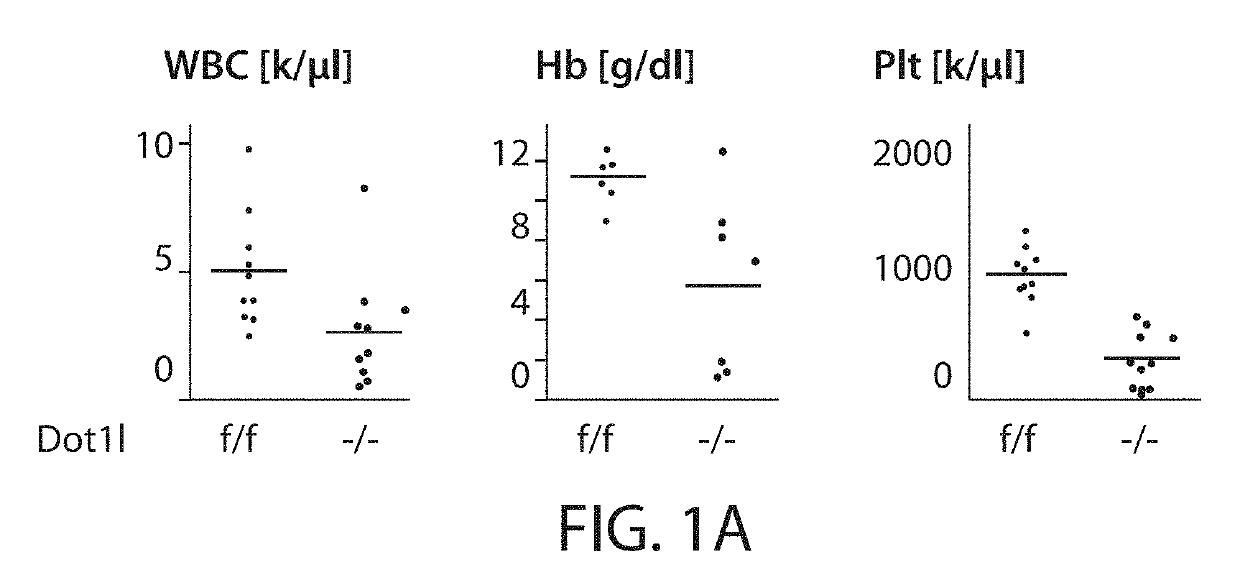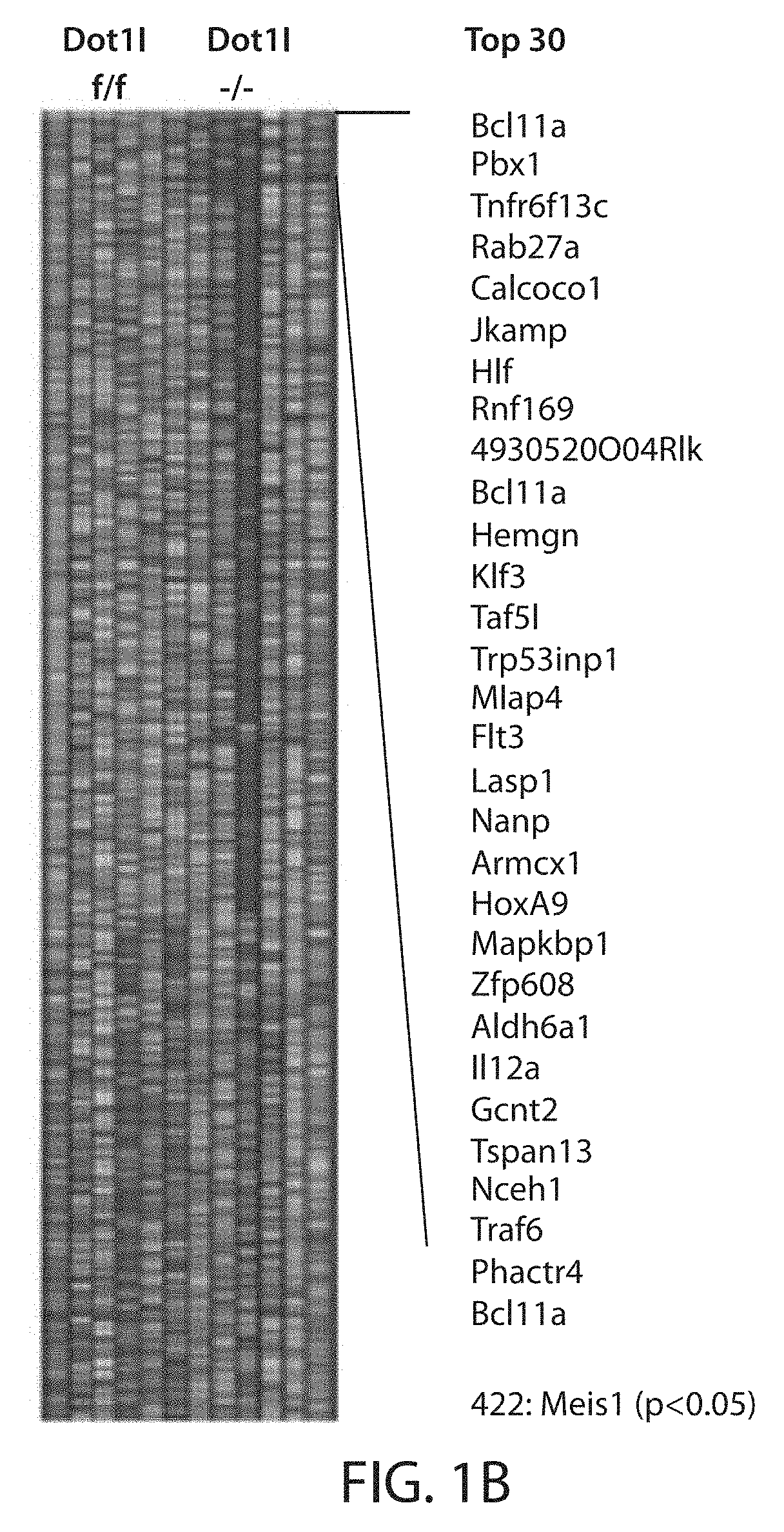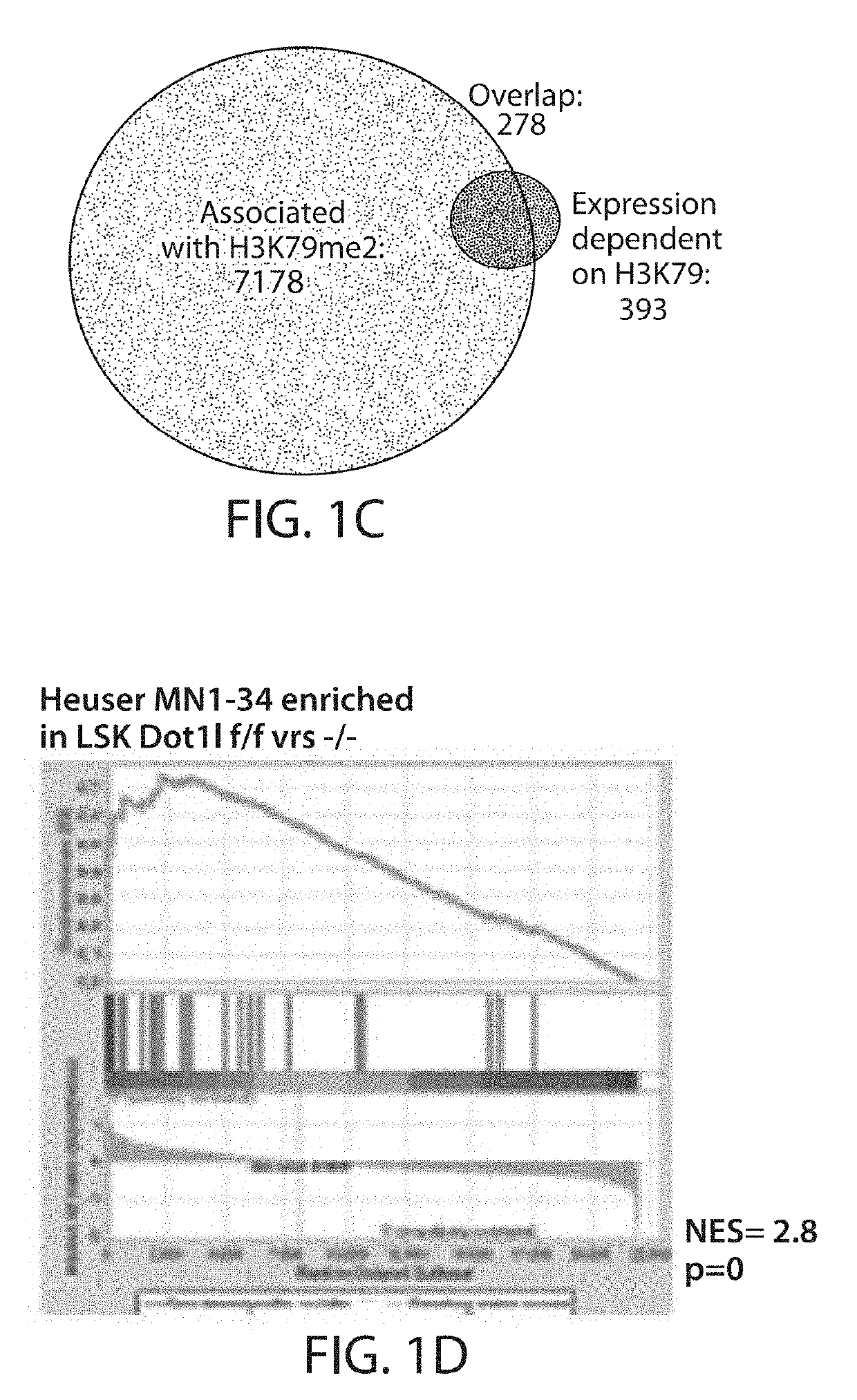Dot1l inhibition in patients with mn1-high aml
a technology of mn1-high aml and dot1l, which is applied in the direction of biochemistry apparatus and processes, instruments, drug compositions, etc., to achieve the effect of preventing or reducing the risk of leukemia
- Summary
- Abstract
- Description
- Claims
- Application Information
AI Technical Summary
Benefits of technology
Problems solved by technology
Method used
Image
Examples
example 1
Materials and Methods
PCR and Primers
[0160]Dot1L Genotyping was performed using primers p2 (CCCAAAAGGGTCTTTTCACA, forward (SEQ ID NO:1)) and p4 (CACAGAGCCATGACCAGACA, reverse (SEQ ID NO:2)). Excision is confirmed using primers p1 (CTCACAGTCACATACTACCTCTGAC, forward (SEQ ID NO:3)) and p3 (ATGGGATTTCATGGAAGCAA, reverse (SEQ ID NO:4)) for the excised allele, and p2 and p3 for the floxed allele.
Generation of MN-1 Leukemias
[0161]The MN-1 cDNA was re-cloned into an MSCV based vector (MIG, MSCV-IRES-GFP) followed by IRES-GFP cassette (MN1-GFP). The MSCV-based Cre-IRES-pTomato (cre) and MSCV-IRES-pTomato (control) or MSCV-based Cre-IRES-trCD2 (cre) and MSCV-IRES-CD2 (control) were cloned by inserting the cDNA or either pTomato or truncated human CD2 in place of GFP in MIG.
Ecotropic Retroviral Vectors
[0162]MN-1-IRES-GFP, Cre-IRES-pTomato, Cre-IRES-trCD2, MSCV-IRES-pTomato or MSCV-IRES-CD2 were generated by cotransfection of 293T cells using FuGENE6 (Roche Molecular Biochemicals, Indianapolis,...
example 2
Loss of Dot1l in Normal Early Hematopoietic Progenitors Leads to Down-Regulation of a Distinct Gene Expression Program
[0182]To delineate early gene expression changes that occur after genetic inactivation of Dot1l in normal hematopoiesis, conditional Dot1lf / f mice were crossed into the MxCre model, which allows rapid and precise excision of exon 5 of the Dot1l gene (which contains most of the active site) after two doses of pI:pC. Induced Dot1lf / f-MxCre mice developed pancytopenia similar to previously reported for conditional Dot1l inactivation models using Tamoxifen inducible systems (FIG. 1A, (Jo et al., 2011; Nguyen et al., 2011)). In the Mx-Cre model, loss of functional Dot1l was confined to the hematopoietic system, and the high efficiency of the MxCre promoter allowed analysis of cell autonomous gene expression changes at a defined early time point. lin- Sca-1+ cKit+ (LSK) cells were isolated 6 days after pI:pC injection. The interferon response elicited by pI:pC treatment ha...
example 3
The Meningeoma-1 (MN1) Cooperating Gene Expression Program is Dependent on Functional Dot1l in LSK Cells
[0183]Heuser et al. (Heuser et al., 2011) reported that a specific, cell of origin derived gene expression program in common myeloid progenitors (CMPs) cooperates with overexpressed Meningeoma 1 (MN1) to cause myeloid leukemia. HoxA9 and Meis1 were identified as key components of this program, and the developmental transcriptional down-regulation at the transition to GMP appears similar to the Dotll-dependent program defined in FIG. 1B. The instant example therefore asks whether this cell-of-origin derived, MN1-cooperating gene expression program is dependent on Dotll in normal early hematopoietic progenitors. Indeed, gene set enrichment analysis demonstrated a strong enrichment of the “Dot1l-dependent in LSK” gene set in the gene expression program that defined MN1 leukemias in the work of Heuser et al. (FIG. 1D).
PUM
| Property | Measurement | Unit |
|---|---|---|
| concentration | aaaaa | aaaaa |
| concentration | aaaaa | aaaaa |
| fluorescent in situ hybridization | aaaaa | aaaaa |
Abstract
Description
Claims
Application Information
 Login to View More
Login to View More - R&D Engineer
- R&D Manager
- IP Professional
- Industry Leading Data Capabilities
- Powerful AI technology
- Patent DNA Extraction
Browse by: Latest US Patents, China's latest patents, Technical Efficacy Thesaurus, Application Domain, Technology Topic, Popular Technical Reports.
© 2024 PatSnap. All rights reserved.Legal|Privacy policy|Modern Slavery Act Transparency Statement|Sitemap|About US| Contact US: help@patsnap.com










